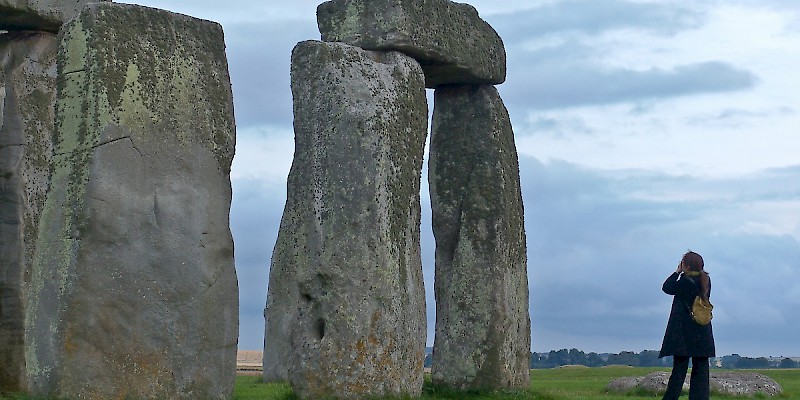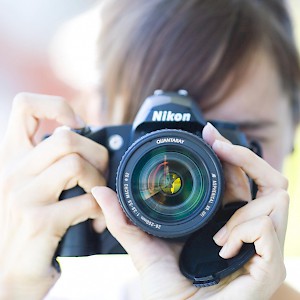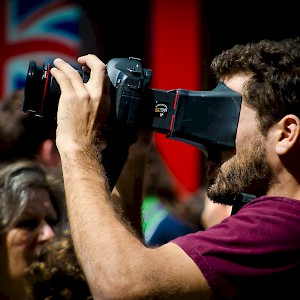General photo and camera tips

General tips, hints, and recommended photo and video gear
What kind of camera to bring
Photo professionals will tell you: The absolute best camera you will ever own is the one you can grab quickly to make the shot. That means if you can whip out your phone to snap that picture of Prince William strolling down Oxford Street, it is far better than digging around in your backpack for your expensive SLR and missing it.
That said, unless you’re a professional or a real heavy-duty amateur, the fanciest camera you need is a basic Digital SLR (Single Lens Reflex) and the kit lens it comes with (though do look for deals that include two lenses, one wide-angle—say an 18–55mm—and a second lens for telephoto—perhaps 55–200mm). Get a lens cap with a little string to dangle it from the lens so you don’t lose it.
This should cost you no more than $700—unless you want it to. Sure, you could easily spend $5,000 on a good digital camera, but the "prosumer" models all clock in at $449 to $1,200 (largely depending on the kind of lens you spring for).
Of course, you can also get by perfectly well with a pocket point-and-shoot digital camera. These days you can get quality digital cameras that shoot 10 megapixels, remain waterproof up to 10 feet underwater, and come with all the bell-and-whistle features for well under $350.
Invest in at least a low-end pocket camera; don’t bother with a disposable camera, which take, at best, passable pictures and even then only under full, bright sunlight. The only useful disposable cameras are, if you think you’ll need one, the ones that work underwater.
Before you leave home: Know thy camera
Practice with your camera before you leave the States, especially if it’s a new one and you’re not sure how it behaves. Visit the sights of your home city, pretend you’re in London, and snap away. Get to know the camera. Shoot indoors and outdoors. Bracket your shots by shooting the same thing several times using different settings, with and without flash, and so on. Write down carefully exactly what you did or varied in each shot so that, later, you'll know which ones worked best.
Sure, you’ll waste half a day doing all this, but it’s better to know how the camera handles with different films and in different situations before you go off and miss that perfect shot on vacation.
Don’t leave home without them: Buying batteries and memory cards
Buy all the memory cards you'll need for your digital camera in the United States. It’s cheaper, and you can be sure it hasn’t been sitting on the shelf since 2003.
I'd suggest bringing a bare minimum of 4 gigs (gigabyte) of memory for every two days on of your trip. Myself, I routinely shoot about a gig a day (more if a festival breaks out), so I travel with enough chips to total about 8 gigs per day to be safe.
Tips
- Make your memory cards last longer by performing imagery triage as you go, deleting extraneous images each evening—those too blurry, underexposed, or poorly framed to be worth keeping—so as to free up more room on the chip for the next day. I tend to do this at dinner table after I've ordered (and taken my notes on the restaurant) and am awaiting my food.
- Bring several spare batteries (if you're using rechargables, you must pack these in your carry-on bag due to new TSA rules as of 2008).
- Use a UV filter on the lens to protect it from scratches (not a polarizing filter, which messes up more shots than it helps if you don’t use it correctly).
- If you do have to buy photo supplies or memory cards abroad, go to a camera shop or department store. Never buy film from a souvenir stand near a tourist sight. The markup is almost criminal.
- REI.com - Since 1938, one of the best all-around outdoors, camping, and adventure travel outfitter, with just about everything you need, whether you're a novice or a hard-core enthusiast. Lots of high-tech clothing designed for heavy-duty wear, tear, travel, and sport, plus everything from packs to personal mosquito nets to biodegradable detergent—and of course, all the basic gear for camping, hiking, mountaineering, mountain biking, skiing, canoeing and kayaking. It's actually run as a co-op, so if you become a member ($15 to join for life), you get 8% cash back on your purchases at the store at the end of the year (10% back if you use the no-fee, free credit card they give you, which also generates 1% back on non-REI purchases). They also have a special clearance-sale section.Partner
- Travelsmith.com - One of the best catalogues out there for travelers (not so much outdoorsy stuff), with high-quality clothing and luggage (and some gadgets) carefully selected or adapted to be perfect for traveling—durable, versatile, wrinkle-resistant, lots of hidden pockets, and sometimes even stylish. My wardrobe's full of stuff with their label on it—though in recent years, they seem to have become increasingly concerned with offering more and more fashion clothing than their old focus on true travel gear. Sad. Also, I should note that some women (my mom and my wife, to be precise) report that the women's clothing is a bit more hit-or-miss—usually excellent, but sometime a big let-down in terms of quality or looks.
- eBags.com - The name really says it all, doesn't it? This is the single best online outlet to compare every concievable type of bag, suitcase, pack, purse, backpack, shoulder bag, duffel, and every other conceivable form of carrying-your-stuff travel container out there—along with related accessories. Good prices, too.Partner
- LLBean.com - This Maine camping clothier and catalogue legend was selling flannel shirts long before Seattle produced its first garage band, and decades before J. Crew and Banana Republic co-opted the outdoorsy look and made it Yuppie. Their travel specialty gear is, as with most of their stock, head and shoulders above anyone else for durability, quality, and utility (if not always style). Best of all: "We guarantee all items for the useful life of the product." That statement is what has hooked people on this storied outfitter since it sold its first pair of boots in 1912. (Its original bricks-and-mortar store in Freeport, Maine became such a site of pilgrimage for vacationing fans of its catalog that it single handedly created the town's now world-famous outlet store industry.)
- Magellans.com - Clothing, luggage, and lots of travel gadgets—some exceedingly useful, others merely ridiculous exercises in technology (seriously, who needs a portable oxygen mask, or a silver case that automatically dispenses credit cards?). Their prices could be lower, but they do carry some prime merchandise difficult to find elsewhere and Magellan's really is the place to go when you're seeking some obscure but useful travel gadget (and I don't mean the collapsible Lexan wine glasses).
- Amazon.com - An obvious one, but a good resource to remember. Everybody's favorite one-stop shopping site on the Internet carries just about anything you could think of.Partner








